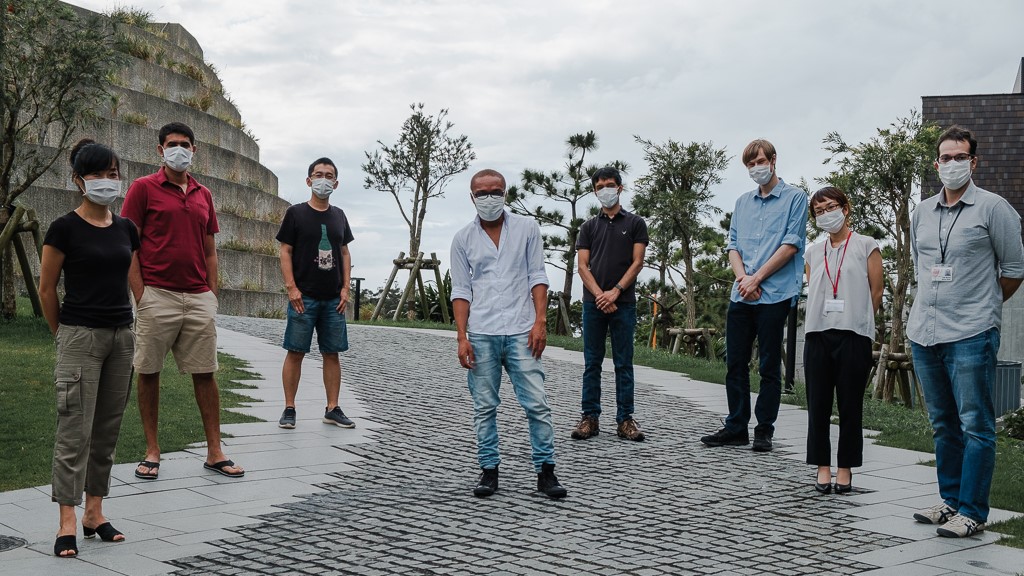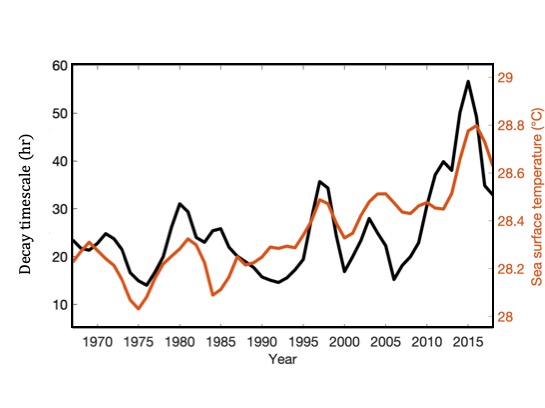FY2020 Annual Report
Fluid Mechanics Unit
Professor Pinaki Chakraborty

Abstract
The Fluid Mechanics Unit pursued research on friction in two-dimensional turbulent flows, the spectral structure of rotating turbulent flows, climate-decay connection in landfalling hurricanes, and granular flows in spinning asteroids.
1. Staff
- Pinaki Chakraborty, Professor
- Tapan Sabuwala, Group Leader
- Julio Manuel Barros Junior, Staff Scientist
- Kalale Chola, Postdoctoral Scholar
- Christian Butcher, Research Unit Technician
- Yuna Hattori, Ph.D. Student
- Hanley Andrean, Ph.D. Student
- Lin Li, Ph.D. Student, Junior Research Fellow
- Tomoe Owan, Research Unit Administrator
2. Collaborations
2.1 Theory of spectral link in turbulent flows
- Type of collaboration: Scientific collaboration
- Researchers:
- Professor Gustavo Gioia, OIST
2.2 Frictional drag in two-dimensional flows
- Type of collaboration: Scientific collaboration
- Researchers:
- Prof. Gustavo Gioia, OIST
- Dr. Alexandre Vilquin, University of Bordeaux, France
- Prof. Hamid Kellay, University of Bordeaux, France
- Prof. Charles-Henri Bruneau, University of Bordeaux, France
- Prof. Patrick Fischer, University of Bordeaux, France
2.3 Granular flows
- Type of collaboration: Scientific collaboration
- Researchers:
- Prof. Troy Shinbrot, Rutgers University, USA
2.4 Transition to elastic turbulence
- Type of collaboration: Scientific collaboration
- Researchers:
- Prof. Amy Shen, OIST
- Dr. Simon Haward, OIST
- Dr. Daniel Carlson, OIST
2.5 Two-dimensional turbulent jets
- Type of collaboration: Scientific collaboration
- Researchers:
- Prof. Marco Rosti, OIST
3. Activities and Findings
3.1 Decay of landfalling hurricanes in a warming world
We studied the decay of hurricane intensity past landfall. It is thought that the evolution of decay is dominated by friction with the land underneath. This non-thermodynamic process has no connection with climate, and thus we may expect that climate exercises no control on the decay. Contrary to this expectation, we showed that the decay timescale for North Atlantic landfalling hurricanes has increased by 94% over the past half-century and that this increase is well correlated with the contemporaneous rise in the sea surface temperature (see the figure below). To unveil a potential link with climate, we conducted simulations of landfalling hurricanes using Cloud Model 1. Our simulations revealed that warmer sea surface temperatures induce a slower decay by increasing the stock of moisture that a hurricane carries as it hits land. This stored moisture constitutes a source of heat that is not considered in current models of decay. Our findings suggest that as the world continues to warm, the destructive power of the slowly-decaying hurricanes will extend progressively farther inland.

3.2 Asymptotic frictional drag in 2D turbulent flows over rough walls
The high Reynolds number asymptotic behavior of frictional drag (f) in turbulent flows over rough walls (of roughness r) is described by the well-known Strickler scaling law: f ~ r^{1/3}. The theory of spectral link unveils that this scaling stems from the underlying turbulent energy spectrum. This insight leads to the novel prediction that the scaling takes a manifestly different form for 2D decaying turbulence: f ~ r. We tested this prediction using unprecedented experiments on rough-walled soap-film flows (see the figure below). Further, we complemented the experiments using numerical simulations. The empirical data defy the predictions of the standard theory of frictional drag but are in excellent accord with the predictions of the spectral link. Our findings provide strong support to the notion that frictional drag and the spectrum are inextricably linked. In FY2020, we successfully completed this collaborative project with the Continuum Physics Unit and the University of Bordeaux.

3.3 Turbulent Taylor-Couette flows
We continued our experiments on the spectral structure of turbulent Taylor-Couette (TC) flows using the OIST-TC setup. To that end, we used the technique of hot-wire anemometry (in the "flying hot-wire" configuration) and computed the spectra from the measured velocity series. The preliminary results suggest that the spectral structure of the small scales in turbulent TC flows is in accord with the theory of small-scale universality.
4. Publications
4.1 Journals
- A. Vilquin, J. Jagielka, S. Djambov, H. Herouard, P. Fisher, C-H Bruneau, P. Chakraborty, G. Gioia, and H. Kellay. 2021. Asymptotic turbulent friction in 2D rough-walled flows. Science Advances, Vol. 7, no. 5, eabc6234. PDF
- L. Li and P. Chakraborty. 2020. Slower decay of landfalling hurricanes in a warming world. Nature, Vol. 587, pp. 230-234. (Featured in Nature News & Views; The New York Times, 11 Nov 2020; BBC, 11 Nov 2020; The Washington Post, 12 Nov 2020; National Geographic,11 Nov 2020; CNN, 11 Nov 2020; The Guardian, 11 Nov 2020; Der Spiegel, 12 Nov 2020; Huffpost, 11 Nov 2020; Fox News, 11 Nov 2020) PDF
4.2 Books and other one-time publications
Nothing to report
4.3 Oral and Poster Presentations
- P. Chakraborty, Spectral theory of frictional drag in wall-bounded turbulent flows: a fresh perspective on an old problem, The 6th Symposium on Theoretical and Applied Mechanics (Online), Keynote Lecture, September 1 (2020).
- P. Chakraborty, The states of flow in transitional pipes, Department of Mechanical Engineering Seminar (online), University of California at Santa Barbara, 19 October (2020).
- C. Butcher, Git IS-NOT-A SCC: The Adapter Pattern over Inheritance, Global LabVIEW Architects Summit, Online, November 10 (2020).
- C. Butcher, Seven things you Can or Can't do with LabVIEW and Docker, Global LabVIEW Architects Summit, Online, November 10 (2020).
- T. Shinbrot, T. Sabuwala and P. Chakraborty, Bennu & Ryugu: Diamonds in the sky, 73rd Annual Meeting of the APS Division of Fluid Dynamics, Online, November 22 (2020).
- L. Li and P. Chakraborty, Cold-cored tropical cyclones, 73rd Annual Meeting of the APS Division of Fluid Dynamics, Online, November 22 (2020).
- T. Sabuwala, P. Chakraborty and T. Shinbrot, How Are Diamond-Shaped Asteroids Sculpted, AGU Fall Meeting 2020, Online, December 8 (2020).
- L. Li and P. Chakraborty, Slow decay of landfalling hurricanes in a warming world, AGU Fall Meeting 2020, Online, December 14 (2020).
- P. Chakraborty, Hurricanes in a warming world, Online public lecture, OIST Foundation, 28 March (2021).
5. Intellectual Property Rights and Other Specific Achievements
Nothing to report
6. Meetings and Events
Nothing to report
7. Other
- Lin Li, Student Excellence in Graduate Research Award, January 2021



